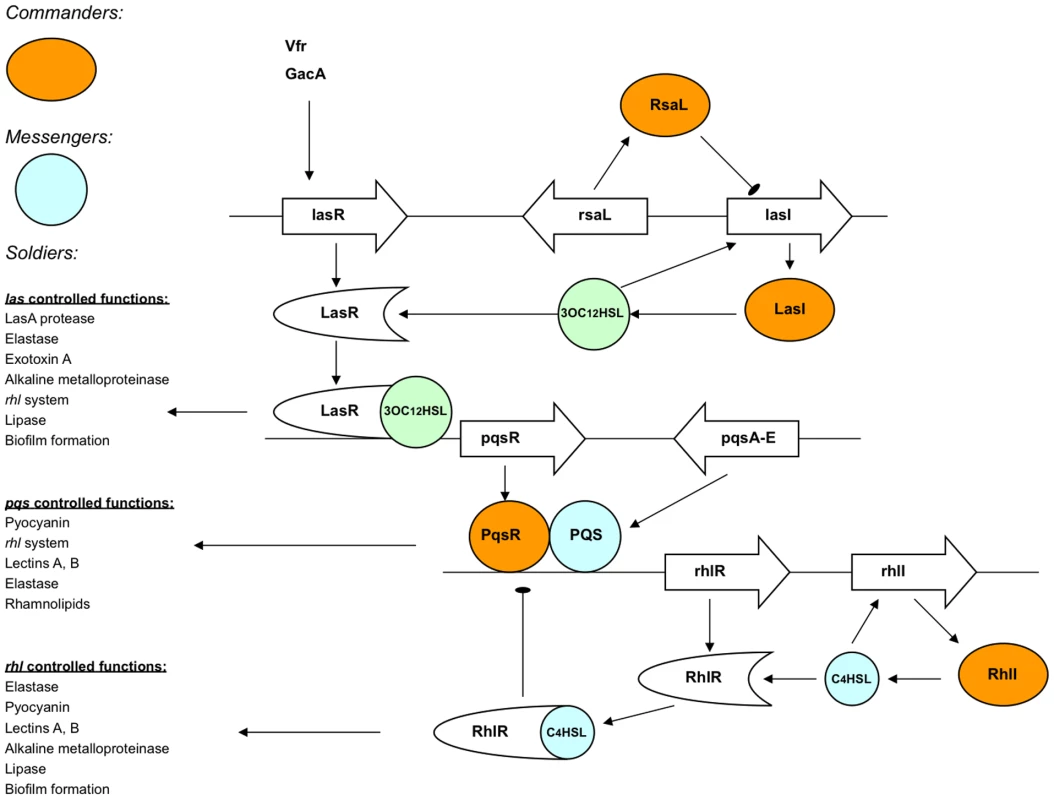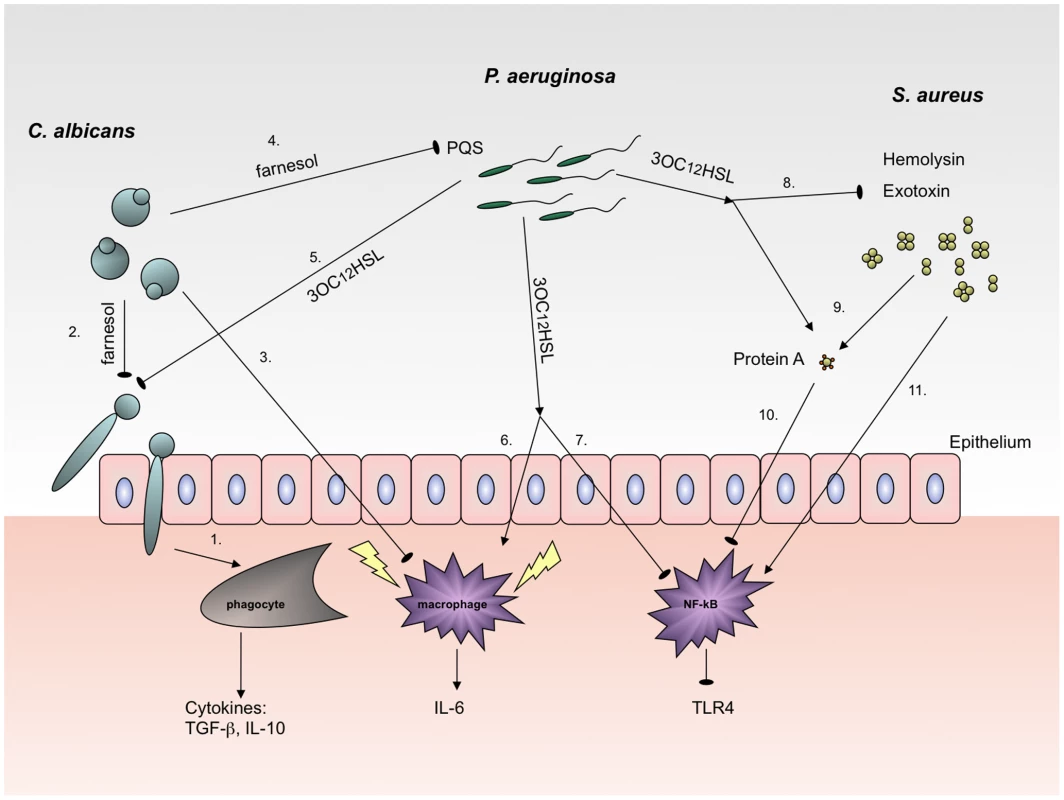Microbial Spy Games and Host Response: Roles of a Small Molecule in Communication with Other Species
article has not abstract
Published in the journal:
. PLoS Pathog 7(11): e32767. doi:10.1371/journal.ppat.1002312
Category:
Pearls
doi:
https://doi.org/10.1371/journal.ppat.1002312
Summary
article has not abstract
Introduction
Gathering and sharing of information is extremely important in human society. Especially in times of war, the difference between victory and defeat can depend on the ability to obtain, encrypt, and share information, and sophisticated systems have been developed for exactly this purpose. Similarly, in their constant battles with competitors and the host immune system, (opportunistic) microbial pathogens have developed sophisticated cell–cell communication systems termed quorum sensing (QS) that allow exchange of critical information. In return, competing microbes, as well as the host immune system, have developed means to intercept and decode these messages. The information obtained by this molecular espionage is used for their benefit, either to win the war (microbe against microbe), or to prepare for an upcoming battle (microbe against immune system). To illustrate the clinical importance of this microbial spy game, we will focus on the biological activity of a single bacterial QS molecule on surrounding microbes and the host immune system and its diverse “meaning” to different receivers. Infections related to burn wounds, cystic fibrosis, and periodontal diseases consist most commonly of the bacteria Pseudomonas aeruginosa and Staphylococcus aureus and the fungus Candida albicans, and represent niches with an active host response. Therefore, we will specifically provide five facts about how the P. aeruginosa QS molecule 3-oxo-dodecanoyl-L-homoserine lactone (3OC12HSL) plays a pivotal role in this triangle of interspecies interactions and how microbial behavior elicited by 3OC12HSL has consequences on host response.
Quorum Sensing: A Sophisticated Communication System
QS is a system that enables microbes to monitor population cell density through the production, secretion, and sensing of small diffusible molecules [1]. When such molecules reach a threshold concentration, microbial cells in the vicinity detect the signal and coordinately respond by modifying their gene expression; often these genes are associated with virulence and pathogenesis. Several different types of QS molecules have been described for a wide variety of microbial species.
In the Gram-negative pathogenic bacterium P. aeruginosa, the QS system is perhaps the most complex because several distinct QS sub-systems are hierarchically intertwined at different stages [2] (Figure 1). The best-studied of these systems is the LasI/R, which consists of the LasI protein that catalyzes the synthesis of the diffusible molecule 3OC12HSL [3]. Intracellular accumulation of 3OC12HSL is sensed by the receptor LasR and induces expression of several virulence factors, such as exotoxins and proteases, and production of secondary metabolites. Significantly, LasR is also responsible for the development and maturation of biofilms, which are communities of surface-adherent microbial species implicated in chronic and resistant infections such as burn wounds, pneumonia in cystic fibrosis patients, and periodontitis [4].

Host Immune Recognition of 3OC12HSL
3OC12HSL is secreted in considerable amounts by P. aeruginosa during growth and is therefore readily detected by the host. Several host cell types, including macrophages and epithelial cells, have been shown to respond to synthetic 3OC12HSL, resulting in both a pro- and anti-inflammatory immune-modulatory response [5]. For example, detection of 3OC12HSL by corneal epithelial cells of the eye results in production of the macrophage attractant cytokine IL-6, creating a strong pro-inflammatory response (Figure 2) [6]. Although intercepting and deciphering microbial communication by epithelial and immune cells could be beneficial for the host, it is important to note that activation of the host immune system could also be beneficial for the pathogen, as over-stimulation of the inflammatory process results in extensive tissue damage. Moreover, 3OC12HSL selectively diminishes the regulation of NF-κB signaling and attenuates TLR4-dependent innate immune responses, which potentially promote infection persistence, particularly in cystic fibrosis patients [7]. The production of 3OC12HSL by P. aeruginosa also suppresses the activation of immune cells and induces apoptosis in macrophages, thereby compromising host immune defenses.

Interspecies Sensing: Detection, Hiding, and Early Warning: P. aeruginosa – S. aureus
Similar to host immune cells, competing bacterial species have developed ways to detect P. aeruginosa through secreted 3OC12HSL. Specifically, the bacterial pathogen S. aureus has been shown to respond to the presence of P. aeruginosa [8]. An important staphylococcal surface protein, protein A, involved in S. aureus defense against the host immune system is up-regulated in response to 3OC12HSL (Figure 2). Binding of the Fc receptor on immunoglobulin G by protein A prevents recognition of S. aureus by macrophages and neutrophils. This could represent a mechanism by which S. aureus prepares itself for an attack of the host immune system.
3OC12HSL induces down-regulation of the sarA and agr genes and consequently, several virulence factors, such as hemolysin, exotoxin, and fibronectin-binding protein, and factors related to biofilm formation are down-regulated in S. aureus in response to P. aeruginosa presence. This response of S. aureus to 3OC12HSL is specific, as no response was observed for 3OC4HSL, nor for unsubstituted acylhomoserine lactones (AHLs), such as C12HSL [8]. Because there is also evidence for binding of 3OC12HSL to a specific receptor in S. aureus, it is conceivable that S. aureus sensing of P. aeruginosa, via detection of 3OC12HSL, could be interpreted as a sophisticated early warning for S. aureus of the presence of a competitor as well as an onset of the host immune response.
Inter-Kingdom Sensing: P. aeruginosa – C. albicans
C. albicans is a dimorphic fungus able to switch morphology between the yeast and hyphal forms [9], a property crucial to its pathogenesis (Figure 2). P. aeruginosa adheres to C. albicans hyphae but not to the yeast morphology, making only the hyphal morphology susceptible to killing by P. aeruginosa [10], [11]. The bacterial factors involved in adhesion to hyphal cells such as the chitin-binding protein (CbpD) are under QS regulatory control (E. Ovchinnikova, B.P. Krom, H.C. van der Mei, and H.J. Busscher, unpublished data). Pseudomonas 3OC12HSL not only regulates the adhesion capabilities to C. albicans hyphae, but also modulates the C. albicans morphological switch by preventing the yeast-to-hypha transition [12], and C. albicans interprets 3OC12HSL as a warning signal.
Interfering with Communication as Potential Therapeutic Strategies
In light of the importance of information exchange, it is not surprising that different systems have developed that interfere with the successful exchange of information. Several mechanisms have been described in the literature, ranging from enzymatic degradation of the signaling molecule to competitive inhibition of receptor binding.
Enzymatic Interference
Many bacteria possess genes that encode lactonases or acylases [13]. These enzymes can deactivate 3OC12HSL and in turn interfere with communication. In fungi, AHL hydrolyzing activity has been observed in Ascomycetes and Basidiomycetes [14]. Although only C6HSL and 3OC6HSL have been shown to be hydrolyzed by these fungi, this example illustrates that fungi have developed systems to interfere with bacterial QS-mediated communication. Similarly, humans have also developed the ability to hydrolyze AHLs via a class of enzymes called paraoxonases (commonly referred to as PONs) [13]. In a Drosophila infection model it was shown that human PONs are protective against P. aeruginosa infections.
Non-Enzymatic Interference
C. albicans secretes farnesol, a QS molecule similar in structure to 3OC12HSL, which at low cell density inhibits Pseudomonas quinolone signal (PQS) production [15] required for the expression of several virulence factors (Figure 2) [16]. At higher concentration, this molecule can suppress the effect of farnesol on PqsR activity [15]. Recently, it was reported that farnesol has a stimulating effect on PQS production in a P. aeruginosa lasR mutant, indicating that there is a specific target for that interaction [17]. P. aeruginosa lasR–deficient mutants arise frequently during chronic infection, likely due to selective advantages in growth, death, and lysis over wild-type cells [18], which suggests that 3OC12HSL might be dispensable for P. aeruginosa virulence. This phenomenon may also reflect the negative effects of the host response to 3OC12HSL on P. aeruginosa survival.
In summary, in addition to playing a pivotal role in virulence, the secreted P. aeruginosa QS molecule 3OC12HSL modulates the host immune response to P. aeruginosa infection and influences the virulence of other opportunistic pathogens. In conclusion, the identification of QS as a microbial strategy to control virulence by means of extracellular signal molecules has identified these molecules as potential drug targets for blocking pathogenicity.
Zdroje
1. NgWLBasslerBL 2009 Bacterial quorum-sensing network architectures. Annu Rev Genet 43 197 222
2. VenturiV 2006 Regulation of quorum sensing in pseudomonas. FEMS Microbiol Rev 30 274 291
3. GambelloMJKayeSIglewskiBH 1993 LasR of Pseudomonas aeruginosa is a transcriptional activator of the alkaline protease gene (apr) and an enhancer of exotoxin A expression. Infect Immun 61 1180 1184
4. DaviesDGParsekMRPearsonJPIglewskiBHCostertonJW 1998 The involvement of cell-to-cell signals in the development of a bacterial biofilm. Science 280 295 298
5. TatedaKIshiiYHorikawaMMatsumotoTMiyairiS 2003 The Pseudomonas aeruginosa autoinducer N-3-oxododecanoyl homoserine lactone accelerates apoptosis in macrophages and neutrophils. Infect Immun 71 5785 5793
6. ZhuHConibearTCThuruthyilSJWillcoxMD 2008 Pseudomonas aeruginosa quorum-sensing signal molecules induce IL-8 production by human corneal epithelial cells. Eye Contact Lens 34 179 181
7. KravchenkoVVKaufmannGFMathisonJCScottDAKatzAZ 2008 Modulation of gene expression via disruption of NF-kappaB signaling by a bacterial small molecule. Science 321 259 263
8. QaziSMiddletonBMuharramSHCockayneAHillP 2006 N-acylhomoserine lactones antagonize virulence gene expression and quorum sensing in Staphylococcus aureus. Infect Immun 74 910 919
9. StaabJFFerrerCASundstromP 1996 Developmental expression of a tandemly repeated, proline-and glutamine-rich amino acid motif on hyphal surfaces on Candida albicans. J Biol Chem 271 6298 6305
10. HoganDAKolterR 2002 Pseudomonas-Candida interactions: An ecological role for virulence factors. Science 296 2229 2232
11. BrandABarnesJDMackenzieKSOddsFCGowNA 2008 Cell wall glycans and soluble factors determine the interactions between the hyphae of Candida albicans and Pseudomonas aeruginosa. FEMS Microbiol Lett 287 48 55
12. HoganDAVikAKolterR 2004 A Pseudomonas aeruginosa quorum-sensing molecule influences Candida albicans morphology. Mol Microbiol 54 1212 1223
13. AmaraNKromBPKaufmannGFMeijlerMM 2011 Macromolecular inhibition of quorum sensing: Enzymes, antibodies, and beyond. Chem Rev 111 195 208
14. UrozSHeinonsaloJ 2008 Degradation of N-acyl homoserine lactone quorum sensing signal molecules by forest root-associated fungi. FEMS Microbiol Ecol 65 271 278
15. CuginiCCalfeeMWFarrowJM3rdMoralesDKPesciEC 2007 Farnesol, a common sesquiterpene, inhibits PQS production in Pseudomonas aeruginosa. Mol Microbiol 65 896 906
16. DubernJFDiggleSP 2008 Quorum sensing by 2-alkyl-4-quinolones in Pseudomonas aeruginosa and other bacterial species. Mol Biosyst 4 882 888
17. CuginiCMoralesDKHoganDA 2010 Candida albicans-produced farnesol stimulates Pseudomonas quinolone signal production in LasR-defective Pseudomonas aeruginosa strains. Microbiology 156 3096 3107
18. HeurlierKDenervaudVHaenniMGuyLKrishnapillaiV 2005 Quorum-sensing-negative (lasR) mutants of Pseudomonas aeruginosa avoid cell lysis and death. J Bacteriol 187 4875 4883
Štítky
Hygiena a epidemiologie Infekční lékařství LaboratořČlánek vyšel v časopise
PLOS Pathogens
2011 Číslo 11
- Diagnostický algoritmus při podezření na syndrom periodické horečky
- Stillova choroba: vzácné a závažné systémové onemocnění
- Perorální antivirotika jako vysoce efektivní nástroj prevence hospitalizací kvůli COVID-19 − otázky a odpovědi pro praxi
- Choroby jater v ordinaci praktického lékaře – význam jaterních testů
- Jak souvisí postcovidový syndrom s poškozením mozku?
Nejčtenější v tomto čísle
- Multiple Candidate Effectors from the Oomycete Pathogen Suppress Host Plant Immunity
- The Splicing Factor Proline-Glutamine Rich (SFPQ/PSF) Is Involved in Influenza Virus Transcription
- A TNF-Regulated Recombinatorial Macrophage Immune Receptor Implicated in Granuloma Formation in Tuberculosis
- SH3 Domain-Mediated Recruitment of Host Cell Amphiphysins by Alphavirus nsP3 Promotes Viral RNA Replication
